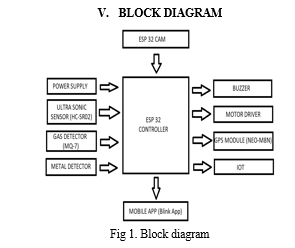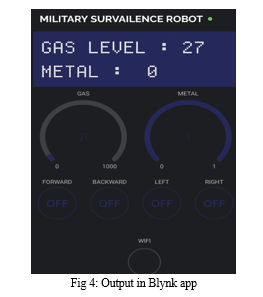Ijraset Journal For Research in Applied Science and Engineering Technology
- Home / Ijraset
- On This Page
- Abstract
- Introduction
- Conclusion
- References
- Copyright
Internet of Things (IOT) Based Military Surveillance
Authors: Mr. Venkataramanaiah ., M. Deepthi, Ch. Manish Chandra, G. Yeshwanth
DOI Link: https://doi.org/10.22214/ijraset.2024.63121
Certificate: View Certificate
Abstract
The ESP32 microcontroller is responsible for controlling this robot and the robot is able to run in both manual mode and automatic mode. A bunch of sensors are mounted on this trolley to collect data and, SUSI now decides what to do with this data based on the instructions received from the ESP32 microcontroller. The system is further empowered with metal detectors used to detect metal explosives that improve its surveillance ability. Such technological developments promise impressive applications in defense where surveillance is key. The proliferation of technology in the last couple of years has given way to the evolution of robotics, thus, transforming many areas for human life, particularly in unsafe environments. Robotic integration has primarily impacted military operations. These robots are enforced to play a major role in the deployment of few dangerous uses which can provide miraculous to the soldiers. Their versatility and effectiveness in different scenarios are provided by the variety of designs that cater for certain operational need. Basically, military robots have increased the military organizations competency to work out challenges which are difficult to address with manual human intervention. These robot helpers are critical to facilitate operational efficiency, and make sure that the personal safety in high-risk environments.
Introduction
I. INTRODUCTION
The combination of military surveillance systems with IoT technologies became a game changer for monitoring, data collection, and threat detection. The robot does not only improve on conventional surveillance techniques but also provides new ways of proactive defense mechanisms.
For national security purposes, underpinned by different activities such as acquiring intelligence from borders and critical infrastructure protection, military surveillance serves as the cornerstone. Typically, surveillance activities like these have depended on human intelligence with others being satellite imagery or ground based sensors. The techniques often meet restrictions such as real-time processing capability or adaptability if compared with range covered in some cases where they have been applied extensively though not entirely without success in specific situations.
The military has been transformed by the use of IoT technology in surveillance so that many devices are connected to each other and may gather, send and process large amounts of information that is received seconds after being collected. Using IoT powered sensors, drones and communication networks, military forces can improve their understanding of events around them, shorten their response time to incidents and reduce security threats better.
The robot for all intents and purposes is basically electro-mechanical machine or device that basically is controlled either by computer program or with electronic circuit to perform variety of for all intents and purposes physical task. In the today’s life robot specifically are becoming indispensable part of for all intents and purposes human life. The robotic technology additionally provides automation in hospital, office and factory. Besides automation this technology withal utilized in Defense forces, Regalement, Space exploration, Security systems and many perilous mission executions. As the terror is always remains India’s first enemy so, the robots are going to utilize for preserving human life. Robot is a hardware device which is mainly made to do various tasks and reduce human efforts. Software and hardware constitute to make machinery which is called robot.
Robotic technology is the future to deploy risky and life threatening tasks. As human’s life is precious and also human cannot reach everywhere so here comes the need of robots to help the humans to overcome their limitations. As robots provide accurate results this has become a great advancement in robot industry. Robots play a crucial role in hazardous environments where human presence is impractical or unsafe, such as hostile territories and high-risk zones. Android Operating system is very much helpful in operating robotic system through smart phones easily.
An IoT-based military surveillance robot is an autonomous or semi-autonomous machine equipped with various sensors, cameras, and communication modules that enable it to perform surveillance tasks. These robots are connected to a central command system via the internet, allowing real-time data transmission and remote control.
II. RELATED WORKS
The system researches the use to which a soldier can communicate with other soldiers in Fars, so that we can enhance the techniques of previous plans.
[1]The authors Bagatti Santhosh Kumar of this paper have proposed a multi-functional robot for remote surveillance in military applications. The proposed system uses a robotic surveillance system for the military and security purpose. P A Harsh Vardhini, K Murali Babu are the authors of this paper. This paper explores IOT-based autonomous robot design implementation for military applications.
In this paper,he proposed design is based on programming with smart app for controlling the robot. The programmer is dumped on to the microcontroller using proteus software. When a Wi-Fi module is connected with robot then an IP address 192.168.4.1 entered in the mobile phone then the controlling options of robot is displayed on the webpage. shows the webpage of the Wi-Fi module where the operation of robot is displayed. When we click on forward, backward, left, right and stops to robot perform the corresponding action and display the action on the LCD display. When we click cam left and cam right options, the camera interfaced to a motor will rotate left and right and capture the video. [3]P A Harsh Vardhini, KMuraliBabu are the authors of this paper. This paper explores about IOT based Autonomous Robot Design Implementation for Military Applications.
This article proposes an artificial intelligence-based design for controlling robots. Use the Arduino IDE software to offload the ESP32 controller's programmer. After the GPS module is connected to the robot, enter the IP address 192.168.4.1 on the mobile phone, the robot options will be displayed on the web page. Shows the Wi-Fi module website showing the operation of the robot. When we go forward, backward, turn left, turn right or stop, the robot will perform the corresponding action and display the action on the LCD screen. When we click on the "camera left" and "camera right" options, the camera connected to the engine will turn left and right and shoot the video. The authors of this article are Saumya Band, Abhishek Merope, Ruturaj Javeri, Shilpa Redrawer, Vaibhav Kale.
This article introduces military surveillance using IoT technology. Suitable for soldiers in combat situations, the system uses the ESP8266 controller along with a series of sensors. This configuration allows the uninterrupted operation of a given application, thereby improving the surveillance capabilities of the battlefield. For good border monitoring, ESP32 camera can also be used for mobile advertising, face detection and facial recognition. Additionally, the proposed system provides accurate measurement of ambient temperature and conditions.
This work presents military surveillance using Internet of Things (IoT) technology. Targeting the specific needs of soldiers in combat situations, the system uses an ESP8266 controller along with a set of sensors. It provides soldiers with combat experience and surveillance capabilities by allowing remote operations through special applications. Also request to provide ambient temperature and conditions. Ravikiran, J. Ajay Kumar Reddy, J. Haria, B.Dr. The author of this article is Swapna Rani. Compact size. It is very easy to install. If the network is not available the system will not work properly. He doesn't know whether he is an ordinary person or an enemy.
The decision-making robot is used for observation purposes only. These robots are suitable for commercial purposes. These robots are used for maintenance purposes. The robot was developed with military use in mind. This article introduces military surveillance using the Internet of Things, a mobile device suitable for use in high-risk border areas and inaccessible areas. This project allows users to control the movement of the rover and the rotation of the camera via the Internet. As a result, the device offers remote control capabilities from anywhere in the world, providing real-time reporting and access to specific regional information. It also has the MQ2 smoke sensor, which detects the presence of smoke and gases in the environment. Areas and areas inaccessible to humans. It allows remote control of rover movement and camera rotation over the Internet, allowing users to control the device from anywhere in the world. This feature provides live broadcast capabilities and access to detailed information about an area. Attention needs to be paid to areas that normal people cannot reach, which is a difficult task due to problems such as temperature, shelter, security problems of the army. It uses the Raspberry Pi-3 board and gives good results compared to other boards. The sensor automatically detects animals around and sends an instant signal. The Raspberry Pi-3 camera captures the image and sends it to the control room.
III. EXISTING METHODOLOGY
Most of the tests are widely used in using DTMF and RF based communication for data transmission. Since the communication frequency of radio frequency is very low compared to other communication technologies, it is used to limit the operating range. Due to line-of-sight operation, it is not suitable for use around obstacles or in environments such as forests. Since humans must control the robot normally, using DTMF to control movement reduces the robot's power.
Robotic systems designed to use mobile phones for data collection and transfer will be more expensive because mobile devices are expensive and such systems are inefficient.
IV. PROPOSED METHODOLOGY
The proposed model uses a ESP32 Module, sensors, a battery of power and the Metal detector which will the detect the bombs give buzzer and on an android phone using an app. The ultrasonic sensor will detect the objects and give alert to displays the messages accordingly on android phone. This robot monitor intruder using ESP32 module using which features like face detection and face recognition is used. The unknown faces will be characterized as an intruder. Sensors like gas, ultrasonic will be interfaced with controller. ESP32 cam pictures are captured and getting a live streaming in output.Live streaming we can see in Blynk app in mobile.
A. Hardware Aspects Identification
The hardware components for our proposed model are:
- ESP32
- ESP32 Cam
- Ultrasonic sensor
- Metal Detector
- Gas Detector
- Power Supply
- Buzzer
- GPS Module
- Motor Driven/ Controller
- Connecting wires
- IOT
B. Software Aspects Identification
The software components to our proposed model are as follows:
- Arduino ide
- Embedded C



Conclusion
The development of IoT-based military surveillance robots for our mission represents a significant step in the military\'s evolution in detection, surveillance, and intelligence collection. Thanks to the integration of technology and robotics, our systems provide many advantages such as instantaneous data collection, unobtrusive operation and good situational awareness. By leveraging IoT sensors and devices, our spy robots can collect a lot of information from their environment, including the environment, enemy movements and threats. The IoT-based military surveillance robot developed for our major project offers a solution to improve military surveillance capabilities. Through the use of technology, illicit operations, and the ability to gather instant intelligence, our system has the ability to change the way the military conducts reconnaissance operations and ultimately help improve situational awareness and objective attainment.
References
[1] Bagwari, “Internet of Things Based Military Assistance and Surveillance”, (ICICS)(p.340-344).doi: 10.1109/ICICS.2018.00076, 2018. [2] AbhijeetDhule, Neha Surbots. \", International Research Journal of Engineering and Technology, IRJET, July 2020. [3] Keerthana. D. NareshBabu, Nivethitha, Gayatri, Leando, \"Design and development of wireless control robot using Internet of Things\", \"International Latest Technology and Engineering Magazine, IJRTE, September 2019 [4] A. Arthi, G. Kalpana, M. Kavitha, Jaya Surya, “Smart spy robot system”, International Journal of State-of-the-art Technology and Engineering, IJRTE, 2018. Paper [5] Abdullah, G.O. E., &Veeramanikandasamy, T. (2017). – Spy robot for monitoring system using Raspberry Pi Internet protocol – 2nd IEEE International Conference on Latest Trends in Electronics, Information and Communication Technologies (RTEICT) (p.86-89).doi: 10.1109/RTEICT 2017.8256563, 2017 [6] P.R. &Hagwan, S., imHased Military Support and Surveillance, International Conference on Intelligence and Systems (ICICS) (pp. 340-344). doi: 10.1109/ICICS 201800076, 2018. [7] Ghute, M.S. Kamble, K. P. Kürtler. M. \"Robot Army.\" In 1st International Conference on Secure Networked Computing and Communications (CSCCC) (pp. 270-272). doi: 10.1109/IC SCCC 2018.8703330, 2018. [8] Prakash, A&Walambe R. doi: 10.1109/PUNECON 2018 8745403, 2018. [9] VaihaviWanjari, ChanchishekharKamangaonkar, “Review of intelligent robots for military surveillance,” International Journal of Research in Engineering and Technology. roll 06:11, ISSN: 2395-4055, November 2019. (2020), \"A Look at Indian Army Research\", https://www.irjet.netarchives/V7/15/RJET V715458pdf [10] Shah, S. and Sharma, R. (2020). - Development of IoT-based monitoring robot using Raspberry Pi, - International Journal of Advanced Research in Computer and Communication Engineering, 9(3), 23-27. Number: 10.17148/IJARCCE.2020.9314 One
Copyright
Copyright © 2024 Mr. Venkataramanaiah ., M. Deepthi, Ch. Manish Chandra, G. Yeshwanth. This is an open access article distributed under the Creative Commons Attribution License, which permits unrestricted use, distribution, and reproduction in any medium, provided the original work is properly cited.

Download Paper
Paper Id : IJRASET63121
Publish Date : 2024-06-05
ISSN : 2321-9653
Publisher Name : IJRASET
DOI Link : Click Here
 Submit Paper Online
Submit Paper Online

